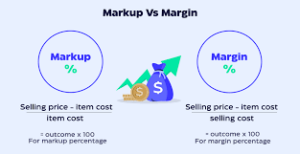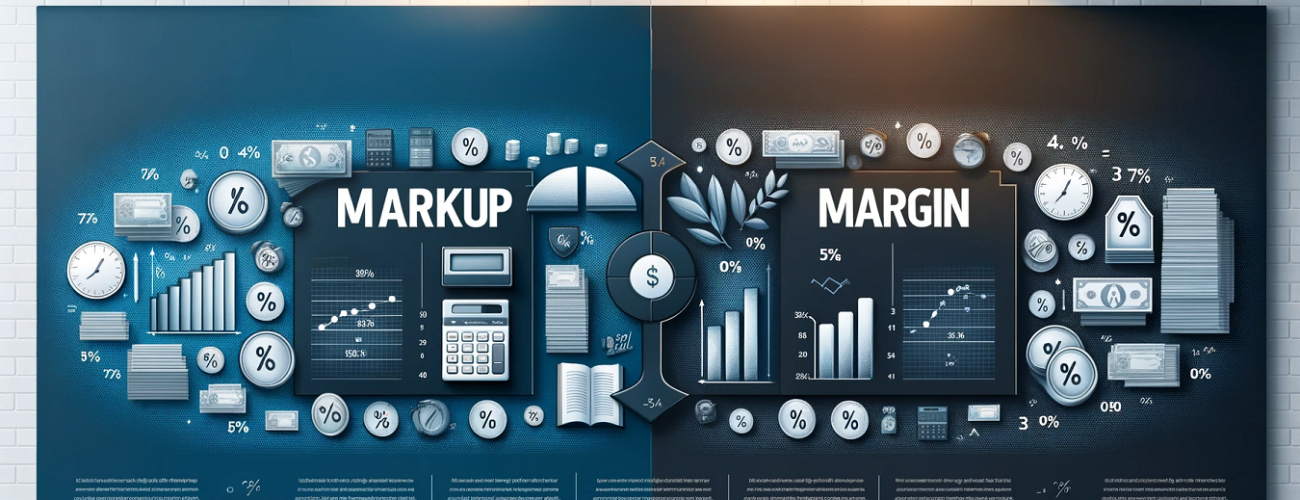Pricing your products or services effectively is a cornerstone of any successful business. But navigating the world of pricing terminology can be confusing, especially when terms like “markup” and “margin” get thrown around. While they’re both related to profitability, they represent different aspects of the pricing equation. Understanding the distinction between markup and margin is crucial for setting prices that ensure your business thrives.

What is profit markup?
Profit markup is a percentage of the cost price added to arrive at the selling price. It essentially represents the amount of profit you aim to make on each product or service.
Calculation:
Markup Percentage = (Selling Price – Cost Price) / Cost Price x 100%
Example:
Imagine a handmade scarf costs $10 in materials and labor to create (cost price). You decide on a 50% markup to cover overhead and generate a profit.
Selling Price = $10 (Cost Price) + ($10 x 50%) = $15
Benefits of using markup:
- Simple to calculate: Markup offers a straightforward way to determine a selling price based on your desired profit margin.
- Easy to communicate: It can be easier for some to understand the concept of adding a percentage markup to the cost price.
Limitations of using markup:
- Doesn’t consider selling expenses: Markup only factors in the cost of producing the product, not additional expenses like marketing, advertising, or rent. This can lead to underestimating your true costs and potentially lower profit margins.
- Doesn’t reflect market value: Markup focuses solely on cost, not necessarily what the market is willing to pay. This can result in overpriced products that struggle to compete.
What is profit margin?
Profit margin, also known as gross margin, is a percentage of the selling price that represents your profit after accounting for the cost of goods sold (COGS).
Calculation:
Gross Margin Percentage = (Selling Price – Cost Price) / Selling Price x 100%
Example:
Using the same handmade scarf example from earlier, the selling price is $15 and the cost price is $10.
Gross Margin Percentage = ($15 – $10) / $15 x 100% = 33.33%
Benefits of using margin:
- Considers all costs: Margin takes into account the full cost of bringing your product or service to market, providing a more accurate picture of profitability.
- Reflects market value: Margin considers the selling price, which is influenced by what customers are willing to pay.
Limitations of using margin:
- Slightly more complex calculation: While still relatively straightforward, calculating margin requires knowing both the selling price and cost price.
Comparison between markup vs margin
| Feature | Profit Markup | Profit Margin |
| Starting Point | Cost Price | Selling Price |
| Calculation | (Selling Price – Cost Price) / Cost Price x 100% | (Selling Price – Cost Price) / Selling Price x 100% |
| Considers | Cost of Production | Cost of Production + Selling Expenses |
| Reflects | Desired Profit | Market Value |
| Advantages | Simple to Calculate, Easy to Communicate | More Accurate Profitability Measure, Reflects Market Value |
| Disadvantages | Doesn’t Consider Selling Expenses, Doesn’t Reflect Market Value | Slightly More Complex Calculation |
Choosing the right approach
There’s no single “correct” approach to pricing. The best method depends on your specific business and pricing strategy. Here are some factors to consider:
- Industry standards: Some industries traditionally use markup for pricing. Research common practices within your sector.
- Pricing complexity: If you have a large product catalog or complex pricing structures, margin might be easier to manage.
- Profit goals: If you have a clear profit margin target, working backward from there might be more efficient.
Here are some general recommendations:
- Use markup for initial pricing estimates: It’s a quick way to set a starting point for your selling price.
- Refine your pricing using margin: Once you have a better understanding of your overall costs, calculate your margin to ensure you’re achieving your desired profitability.
- Track and analyze both: Monitor both markup and margin to understand how changes in costs or selling prices affect your profitability.
Conclusion
Understanding the differences between profit markup and margin empowers you to make informed pricing decisions. By considering both cost and market value, you can set prices that generate healthy profits while remaining competitive. Remember, pricing is an ongoing process. Regularly evaluate your markup and margin, experiment with different pricing strategies, and adapt to changing market conditions. With a data-driven approach and a clear understanding of these key pricing concepts, you can unlock the true potential of your pricing strategy and propel your business towards long-term success.

